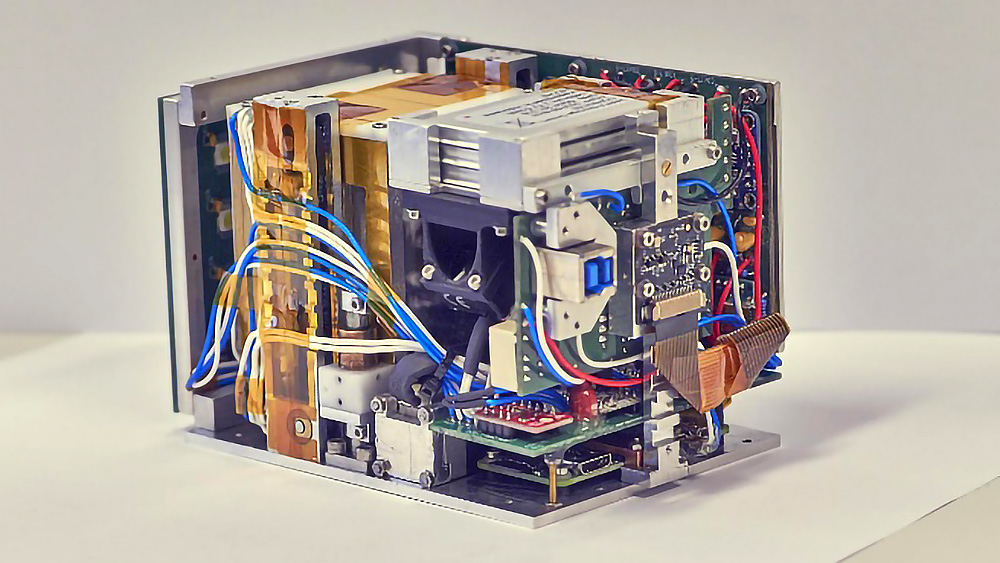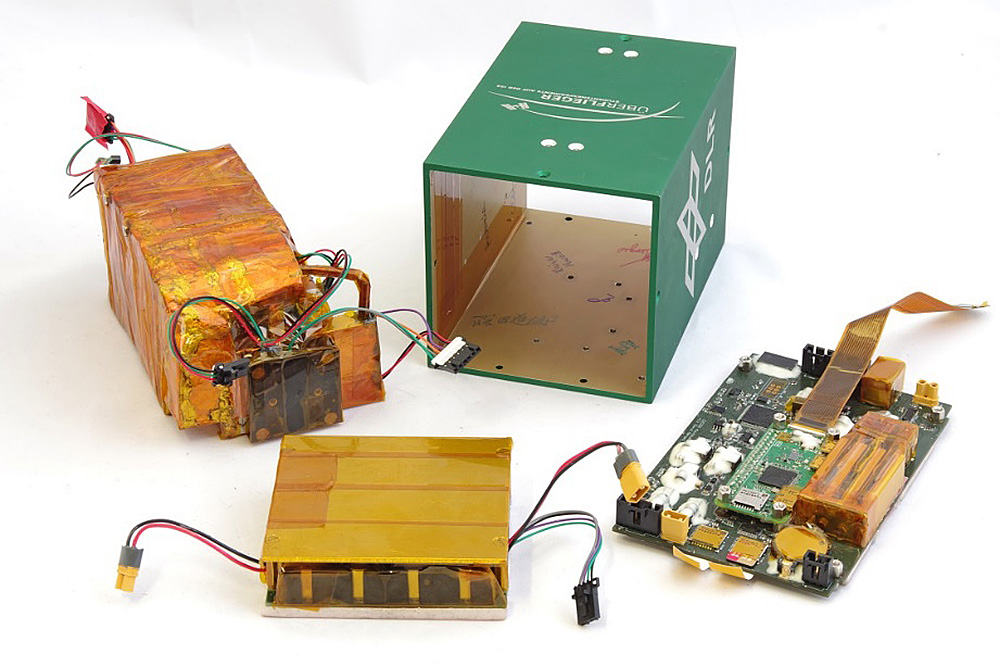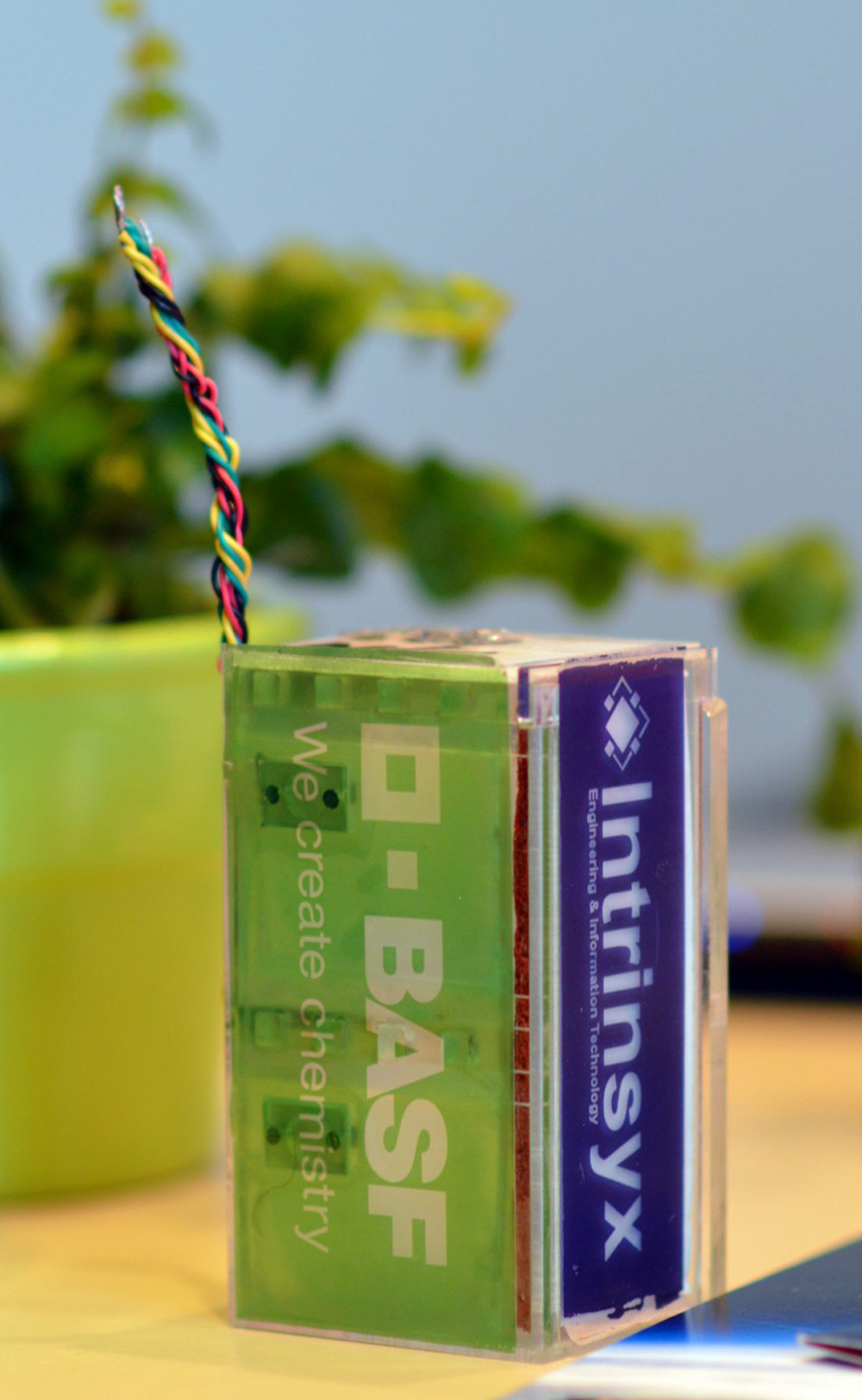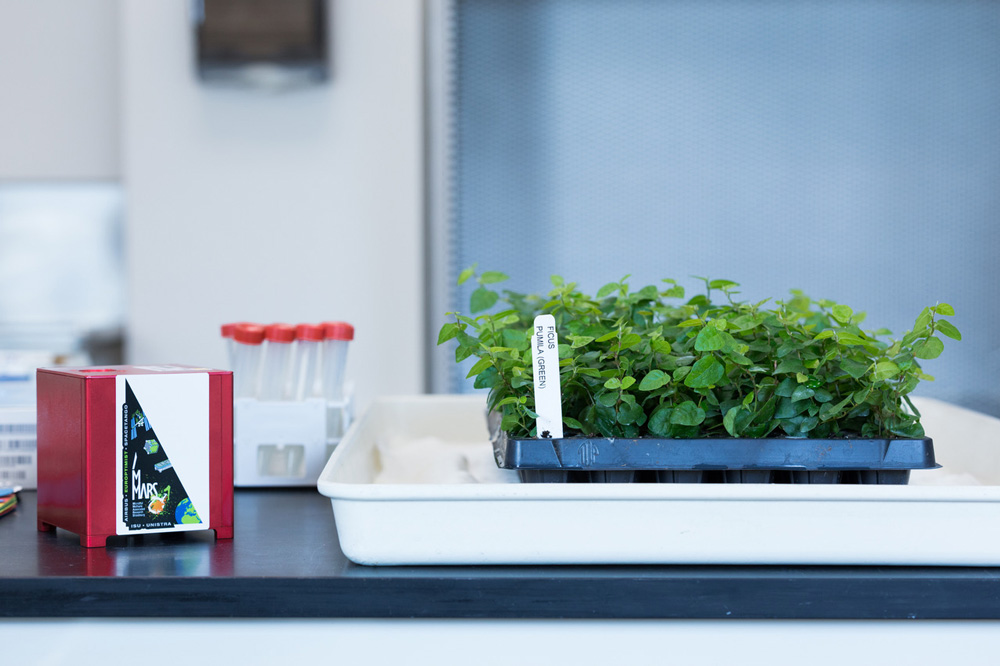Are you studying at a university in Germany or Luxembourg?
Do you have an idea for an experiment on the International Space Station ISS?
If so, submit your idea here by 15.10.2021. The scientific or technical background of the experiment idea does not matter. But it is important that it has scientific and/or technological merits and that they are feasible. The four best experiment proposals (three from Germany and one from Luxembourg) will fly to the ISS. During the programme, you will learn how to develop, build and ultimately carry out a real experiment on the ISS. And on top, you will be able to attend the launch of the rocket with your experiment.
Conditions of participation
- You are currently enrolled at a German or Luxembourg university as a student or a PhD candidate* and will be until the end of the programme (spring 2023).
- You have a team of at least four motivated fellow students. We recommend a team composed from different disciplines (e.g. natural sciences, engineering, computer science, public communications).
- You are ready to invest regular time parallel to your studies over the course of the programme.
- You have an innovative idea for an experiment on the International Space Station ISS that makes good use of the specific conditions there (e.g. zero gravity and increased radiation).
- Each selected team will receive financial support of €20,000, which can be used for expenses related to the development and construction of the experiment. The financial support cannot be used to cover personnel costs and any expense has to be validated by the organisers.
* PhD candidates, that are registered at and are carrying out their research project at a Luxembourgish public research institute, can also participate in Überflieger 2, regardless of the university they are affiliated to.
General technical conditions
- Your experiment will be accommodated inside the ISS.
- Your experiment will fit into a 2U container measuring 20 x 10 x 10 centimetres.
- Your experiment will weigh a maximum of 2 kilograms.
- Your experiment does not involve any explosive, flammable or hazardous substances.
- Your experiment must be able to be carried out with 3.3 V, 5 V or 12 V.
- The maximum electrical power of your experiment must be:
- 6.6 W @ 3.3 V
- 10 W @ 5 V
- 12 W @ 12 V
- Your experiment must run mostly autonomously and does not require the direct intervention of an astronaut.
- Your experiment must use an UART interface to download the telemetry data and upload telecommands. Scientific data of your experiment will be transferred via an USB interface.
In the Interface Control Document (ICD) of our implementation partner Space Tango you can find further information about how to accommodate your experiment in the experiment container.
Frequently Asked Questions (FAQs)
In order to help you with formulating your experiment idea, we are here listing some FAQs and the answers to them.
Can teams be made up of students from different universities or does the principle of “one team – one university” apply?
Yes, teams may also consist of students from different universities.
Are medical students (Staatesexamen) allowed to participate in the programme?
As long as you are enrolled as a student at a German or Luxembourg university, you can take part in Überflieger 2. The field of studies does not matter.
Is it possible to change team members during the application phase or during implementation?
Yes, in principle a change of team members is possible at any time. It should only be ensured that there is always a team that is able to work. Changes in the team leadership must be reported to the organiser in good time.
Does our team have to include people who take care of the mechanical design, electronics and software?
Yes, every team should have people who take care of these aspects. Of course, certain work and components can also be bought in from third parties. For example, our supplier offers control electronics including software. This must then be paid for out of the team budget.
Are we free to decide on the use of our team budget?
Yes, as long as the expenses are directly related to your project. An exception are personnel costs for your team members. These are not reimbursable.
Do sponsors already have to be presented with the application?
When applying, a concept should be presented of how the team plans to finance the work around the experiment. Fixed agreements with sponsors do not have to be presented.
Are the experiments scheduled to fly with a specific astronaut?
The Überflieger 2 experiments are scheduled to fly to the ISS in Q4 2022 or early 2023. They are not linked to specific astronaut missions. They will therefore not be on the ISS during Matthias Maurer’s current mission.
Will the experiment container be provided or will you have to make them yourself?
Each winning team will be provided with an experiment container.
Will we get the experiment back after its stay on the ISS?
Provided it adds scientific value, it is also possible to return the experiment.
The call for proposals states that the project should be “largely autonomous”. What does that mean? What might a non-autonomous part of an experiment look like?
Autonomous refers to the interaction with astronauts. This should be kept to a minimum. It might be possible, for example, to have the astronaut do a few things during installation on the ISS. In the later course of the experiment, however, the operation should be controlled from the ground as far as possible. Regular work by the astronauts is not possible.
In the ICD for the 2U container it looks like there are 2 D-Sub connectors. Are we allowed of using both?
Yes, there are 1 or 2 connectors as the team wants and both can be used. This is because there is one connector per 1U.
Is it allowed to use GMOs (plants, other genetically modified organisms)? Are these classified as hazardous substances or can they be used and incorporated in experiments under certain circumstances?
That depends entirely on the GMOs. There are some that are only slightly modified and have a low bio-safety class (S1) and then there are some that are S2 or higher. So in principle it is possible, but you have to look at the exact type of GMOs.
What are the safety requirements for liquids?
Here, the so-called “tox level” is particularly important. If it is considered toxic, you have to provide certain levels of containment – the hardware must then have 1-3 levels of containment, whereby the 2U cube from SpaceTango already has 2 levels of containment. In addition, the inner hardware could have further levels of containment.
Is it possible to cool the experiment before arrival at the ISS? What about the power supply on the way to the ISS?
The experiments can be transported to the ISS cooled. It is very common to bring up biological experiments in particular at 4°C. However, it is the case that the experiments are cooled before they arrive at the ISS. However, there is no active cooling. The experiments are stored in cooling bricks, which maintain the temperature for about 72 hours. There is no power supply. As soon as the experiments are installed, they are connected to the power and data network. In Überflieger 2, the experiments are installed at room temperature and there is no possibility of cooling or heating in the facility itself. There is ambient temperatur there, so about 20°C.
Can you give a rough order of magnitude of how much the cooling on the way to the ISS would cost approximately?
The temperature-regulated upload of a 2U experiment costs about US$2,500.
How soon can the experiment go into operation after the rocket launch?
The earliest installation date (for time-critical experiments, e.g. in biology) is 72 hours after rocket launch. From then on, it is possible to supply the experiments with power and data.
Is temperature control of biological experiments possible?
No, the temperature will be around the room temperature on the ISS (approx. 22°C). You can play a little with individual degrees via the selection of the position, but it will be within this range.
Is it possible to dissipate heat into the structure?
In principle, high temperatures should not be dissipated (not above approx. 50°C). It is important that no temperatures higher than 45°C are reached at the front of the system, otherwise it would be dangerous for the astronauts.
Is there data on accelerations on the ISS (e.g. during manoeuvres)? Is it permissible to operate the experiment during such manoeuvres? Can the operation of our experiment be planned so that such a manoeuvre takes place during it?
Yes, there is data on this. Operation during such manoeuvres is possible in principle, but we cannot synchronise the experiment with the manoeuvres. There are no plannable data on this that would be made available to us.
How long will it be possible to operate the experiment?
The standard operating time on the ISS is 30 days. The costs for a possible longer operating period must be covered from the team budget.
How is the experiment operation carried out: Will communication with the experiments be enabled via mails and staff or will one have direct access/uplink/downlink?
An attempt is made to work out an exact timeline in advance (also with the help of the simulator). In emergencies, communication runs directly via the provider and there is the possibility of an uplink and downlink.
The scientific data is transferred via the USB interface. How exactly does that work? Or how exactly do we get the data in the end? Are they transmitted live or do we get a memory card back at the end?
Both, everything is made available at the end. Also, data is downloaded several times a day and can be viewed on the platform.
How long does it take before someone has access to it after our experiment returns (e.g. to retrieve samples)?
If we land in the Atlantic it is 12 hours, if we land in the Pacific it is 72 hours until access. It is not yet clear which case will occur with Überflieger 2. But the experiment can be temperature-controlled the whole time.
Additional questions regarding your participation in Überflieger can be submitted to info@ueberflieger.space at all time.
Submitting the experiment proposal
You can submit your experiment proposal until 15.10.2021 by filling in and signing the required documents (see below) and sending them to the following email address: info@ueberflieger.space.
The required documents are:
Programme sequence
The winning experiments will be selected in a two-stage process:
- All experiment proposals submitted will be assessed by a panel of experts. The best eight proposals from Germany and the best three proposals from Luxembourg will be invited to a selection workshop.
- In the run-up to the selection workshop, the selected teams can further develop and refine their experiment proposal.
- At the selection workshop, the teams will present their experiment proposals directly to the panel of experts and answer their questions. The jury will then select the three best German and the best Luxembourg experiment proposals.
Timetable
| When | What | Where |
|---|---|---|
| until 15.10.2021 | Submission of the experiment proposals | Online |
| End of November/early December 2021 | Selection workshop | DLR Bonn* |
| Mid-February 2022 | Preliminary Design Review (PDR) | Luxembourg* |
| Mid-June 2022 | Critical Design Review (CDR) | At your team location |
| Mid-September 2022 | Flight Readiness Review (FRR) | At your team location |
| 4th quarter 2022 or 1st quarter 2023 | Transport to the ISS and travel to the launch site | Probably USA* |
| 4th quarter 2022 or 1st quarter 2023 | Experiment operations on the ISS | ISS |
This timetable is for guidance only. It can be adapted to the actual progress of the project and is of course also dependent on the development of the current COVID19 pandemic.
* Travel costs will be covered by the organiser within a previously communicated limit.
The first Überflieger competition started in December 2016. Then open to students at Germany universities only. The three winning teams were selected in Mai 2017 among more than 20 candidates. The three experiments were launched to the ISS in the summer and autumn of 2018 and subsequently operated on-board of the station. In the following we would like to introduce the three experiments. They can be an inspiration for your very own experiment ideas.
ARISE
ARISE (Planet formation due to charge induced clustering on ISS) was developed and built by students of the University of Duisburg-Essen. The experiment investigated the role electrical charges play in the birth of new celestial bodies. So far, particles up to several centimetres in diameter are known to stick together in collisions. However, this only works up to a certain size of accumulation. A new theory proposes that larger clusters are formed by electrical interactions. To test this assumption, the students had the collisions of glass beads simulating cosmic particles observed under zero gravity.
Überflieger-Studierendenexperimente auf der ISS (PAPELL & ARISE) – YouTube (German only)

EXCISS
The EXCISS experiment (Experimental Chondrule Formation at the ISS) by students at the Goethe University Frankfurt am Main investigated the formation of planets in the early solar system. The focus was on so-called chondrules, small lumps of mineral components that form the basis of special meteorites called chondrites. These meteorites originate from the earliest phase of planet formation. In the experimental procedure, the team observed a sand dust cloud that was continuously exposed to electrical flashes. The energy of the flashes caused collisions and fusion of the mineral particles.
Alexander Gerst: Überflieger-Studierendenexperimente auf der ISS (EXCISS) – YouTube (German only)

PAPELL
PAPELL (Pump Application using Pulsed Electromagnets for Liquid relocation) was the name of the technology experiment conducted by the team of students at the Universität Stuttgart. A new type of pump technology was investigated that could be used, for example, to supply fuel for space missions. The pump moved a so-called ferrofluid, i.e. a magnetisable liquid, with the help of electromagnets. This meant that this pump did not require any moving mechanical components. This would minimise the susceptibility of pumping equipment to failure and help to contain noise during operation, which would benefit astronauts inside the spacecraft. In two sub-experiments, the transport of the liquid as well as small solid pellets was experimentally tested.
Überflieger-Studierendenexperimente auf der ISS (PAPELL & ARISE) – YouTube (German only)

V3PO – Vegetative Plant Growth (Edith Stein School in cooperation with BASF)
The central question posed by the students: Can vegetables be vegetatively grown and propagated in space so that fresh food is available during space missions – without having to carry large quantities of seeds? This has piqued the curiosity of BASF and NASA. So far, experiments conducted in microgravity have focused on the growth behaviour of roots during seed germination. Cuttings, unlike a seed, do not yet contain a root system. The students investigated whether and how roots as well as shoots and leaves form in cuttings without the influence of gravity. They therefore developed a 2-chamber hardware for 8 seedlings that fit in a 1.5 U form factor.

MMARS-1 (International Space University in cooperation with University of Strasbourg)
This investigation seeked to examine how methanogens—methaneproducing bacteria that play critical roles in several microbiomes—adapt to microgravity and alter their metabolic activity and growth. Methanogens contribute to microbiome health in the human digestive system, and this experiment added to researchers’ fundamental knowledge of this important microbe. Many microorganisms respond by increasing cell division or metabolic activity. The growth curve was monitored by indirectly measuring methane production throughout the flight experiment via changes in internal pressure. Decoupling of growth to metabolic activity was determined by comparing final methane to cell density of flown samples and ground controls. Freshly inoculated samples were used to characterize the early portions of the growth while higher density cultures were used to characterize the later portions of the growth. The experiment was conducted within a 1U cube on the Space Tango ISS facility.

German Space Agency at DLR
We, the German Space Agency, undertake statutory tasks in the space sector on behalf of the German Federal Government. Under the “Raumfahrtaufgabenübertragungsgesetz” and within the scope of the tasks effectively assigned to us, we implement the space strategy of the Federal Government, develop and manage the national space programme, and represent the interests of the Federal Republic of Germany in space-related international bodies in accordance with the tasks assigned to us. We advise the Federal Government and develop initiatives and strategic approaches for space policy. All of our activities are based on the guidelines laid down by the Federal Government in its space strategy.
With our missions and projects, we strengthen Germany’s scientific excellence and expand the technological expertise and global competitiveness of German industry. Promoting the commercialisation of space technologies, the innovation potential of German SMEs and technology transfer are essential tasks of our industrial policy mandate. Space technologies and applications are intended to benefit people on Earth and improve the quality of life in Germany, Europe and the rest of the world.
Our space missions make a significant contribution to solving global and societal challenges. Examples include providing information on climate change and climate protection, the further development of digitalisation and communications technologies, and contributions to national security. We make the results of our missions and projects publicly available. We inform the public about new scientific findings and promote awareness of the relevance of space for everyday life. Last but not least, we strive to spark interest and enthusiasm among young people for the natural sciences in general and space in particular.
Luxembourg Space Agency (LSA)
Established in 2018 with the goal of developing the national space sector, the Luxembourg Space Agency fosters new and existing companies, develops human resources, facilitates access to funding and provides support for academic research. The agency implements the national space economic development strategy, manages national space research and development programs, and leads the SpaceResources.lu initiative. The LSA also represents Luxembourg within the European Space Agency, as well as the space related programs of the European Union and the United Nations.
Deutsche Physikalische Gesellschaft (DPG)
With a tradition going back to the year 1845 the Deutsche Physikalische Gesellschaft e. V. (DPG) is the oldest and comprising around 55,000 members also the largest national physics association worldwide. It regards itself as an open forum of physicists and being a non-profit association does not pursue economic interests. With conferences, events and publications, the DPG promotes the transfer of knowledge within the scientific community and aims to open a window on physics to all those who are curious. Special focal points are the promotion of young scientists and equal opportunities. The DPG is based in Bad Honnef and its representation in the capital is the Magnus-Haus in Berlin.
yuri GmbH
yuri GmbH is a young German space company offering the full range of services in microgravity, from experiments on parabolic flights to complex missions on the International Space Station. It takes care of the entire process from idea to implementation. Customers benefit from expertise gained from 11 successful ISS missions and a total of more than 30 years of experience in the space industry. Compared to other providers, yuri GmbH offers modular and reusable experiment hardware and can operate it on European, American and Japanese ISS research facilities. This means that the most cost-effective and technically best tailored concept can always be offered for every customer requirement. With its approach, yuri GmbH has already been able to win well-known customers such as NASA, ESA or DLR, the pharmaceutical company GSK or research institutes such as UCLA in California, UTS Sydney or the Berlin Charité for ISS projects.
Überflieger Team DLR
German Space Agency at DLR
Department Research and Exploration
Königswinterer Str. 522-524
53227 Bonn
Germany
ueberflieger@dlr.de
+49 228 447-358
Überflieger Team LSA
Luxembourg Space Agency
19-21, boulevard Royal
L-2449 Luxembourg
bob.lamboray@space-agency.lu